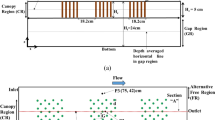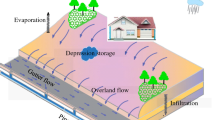Abstract
This article used various hydrodynamic and sediment transport models to analyze the potential and the limits of different channel schematizations. The main aim was to select and evaluate the most suitable simulation method for fine-grained sediment remobilization assessment. Three types of channel schematization were selected to study the flow potential for remobilizing fine-grained sediment in artificially modified channels. Schematization with a 1D cross-sectional horizontal plan, a 1D+ approach, splitting the riverbed into different functional zones, and full 2D mesh, adopted in MIKE by the DHI modeling suite, was applied to the study. For the case study, a 55-km stretch of the Bílina River, in the Czech Republic, Central Europe, which has been heavily polluted by the chemical and coal mining industry since the mid-twentieth century, was selected. Long-term exposure to direct emissions of toxic pollutants including heavy metals and persistent organic pollutants (POPs) resulted in deposits of pollutants in fine-grained sediments in the riverbed. Simulations, based on three hydrodynamic model schematizations, proved that for events not exceeding the extent of the riverbed profile, the 1D schematization can provide comparable results to a 2D model. The 1D+ schematization can improve accuracy while keeping the benefits of high-speed simulation and low requirements of input DEM data, but the method’s suitability is limited by the channel properties.









Similar content being viewed by others
References
Aksoy, H., & Kavvas, M. L. (2005). A review of hillslope and watershed scale erosion and sediment transport models. Catena, 64(2–3), 247–271.
Amos, C. L., Bergamasco, A., Umgiesser, et al. (2004). The stability of tidal flats in Venice Lagoon—the results of in-situ measurements using two benthic, annular flumes. Journal of Marine Systems, 51(1–4), 211–241.
Ariathurai, R., & Arulanandan, K. (1978). Erosion Rates of Cohesive Soils. Journal of the Hydraulics Division, 104(2), 279–283.
Bagnold, R.A. (1966). An approach to the sediment transport problem from general physics. U.S. Geological Survey Professional Paper 422-I.
Breusers, H. N. C. (1986). Lecture notes on sediment transport problem. Delft: International course of hydraulic engineering.
Büttner, O., Otte-Witte, K., Krüger, F., Meon, G., & Rode, M. (2006). Numerical modelling of floodplain hydraulics and suspended sediment transport and deposition at the event scale in the middle river Elbe, Germany. Acta Hydrochimica et Hydrobiologica, 34, 265–278.
Cao, Z., Li, Z., Pender, G., & Hu, P. (2012). Non-capacity or capacity model for fluvial sediment transport.Proceedings of the. ICE - Water Management, 165(4), 193–211.
Caviedes-Voullième, D., Morales-Hernandéz, M., López-Marijuan, I., & García-Navarro, P. (2014). Reconstruction of 2D river beds by appropriate interpolation of 1Dcross-sectional information for flood simulation. Environmental Modelling & Software, 61, 206–228.
CHMI (2013). Hydrological yearbook. CHMI, Prague.
Cook, A., & Merwade, V. (2009). Effect of topographic data, geometric configuration and modeling approach on flood inundation mapping. Journal of Hydrology, 377(1–2), 131–142.
Costa, S., & Coelho, C. (2011). Suspended sediment concentration importance on cohesive sediment settling velocity. Journal of Integrated Coastal Zone Management, 11(2), 171–185.
DHI (2012). MIKE 21 & MIKE 3 flow model - Scientific documentations. Horstholm.
Droppo, I. G., Liss, S. N., Williams, D., Nelson, T., Jaskot, C., & Trapp, B. (2009). Dynamic existence of waterborne pathogens within river sediment compartments.Implications for water quality regulatory affairs. Environmental Science & Technology, 43(6), 1737–1743.
Fang, H., Chen, M., & Chen, Q. (2008). One-dimensional numerical simulation of non-uniform sediment transport under unsteady flows. International Journal of Sediment Research, 23(4), 316–328.
Frank, E., Sofia, G., & Fattorelli, S. (2012). Effect of topographic data resolution and spatial model resolution on hydraulic and hydro-morphological models for flood risk assessment. In S. Mambretti (Ed.), Flood risk assessment and management. Southhampton: WIT Press.
Galappatti, R., & Vreugdenhill, C. B. (1985). A depth-integrated model for suspended transport. Journal of Hydraulic Research, 23(4), 359–377.
Ghostine, R., Vazquez, J., Terfous, A., Mose, R., & Ghenaim, A. (2012). Comparative study of 1D and 2D flow simulations at open-channel junctions. Journal of Hydraulic Research, 50(2), 164–170.
Giere, O. (2009). Meiobenthology. Heidelberg: Springer-Verlag Berlin.
Grabowski, R. C., Droppo, I. G., & Wharton, G. (2011). Erodibility of cohesive sediment: The importance of sediment properties. Earth-Science Reviews, 105(3–4), 101–120.
Guerrero, M., & Lamberti, A. (2013). Bed-roughness investigation for a 2-D model calibration: the San Martín case study at Lower Paranà. International Journal of Sediment Research, 28(4), 458–469.
Haddadchi, A., Ryder, D. S., Evrard, O., & Olley, J. (2013). Sediment fingerprinting in fluvial systems: review of tracers, sediment sources and mixing models. International Journal of Sediment Research, 28(4), 560–578.
Hardy, R. J. (2013). Process-Based Sediment Transport Modeling. In J. F. Shroder (Ed.), Treatise on Geomorphology, volume 2: Quantitative Modeling of geomorphology (pp. 147–159). London: Elsevier.
Heininger, P., Pelzer, J., Claus, E., & Pfitzner, S. (2003). Results of Long-term Sediment Quality Studies on the River Elbe. Acta Hydrochimica et Hydrobiologica, 31, 356–367.
Heise, S., Krüger, F., Förstner, U., Baborowski, M., Götz, R., & Stachel, B. (2008). Bewertung von Risiken durch Feststoffgebundene Schadstoffe im Elbeeinzugsgebiet. In Zusammenfassungen der Studien. Hamburk: Hamburg Port Authority.
Horritt, M. S., & Bates, P. D. (2002). Evaluation of 1D and 2D numerical models for predicting river flood inundation. Journal of Hydrology, 268(1–4), 87–99.
Hostache, R., Hissled, C., Matgen, P., Guignard, C., & Bates, P. (2014). Modelling suspended-sediment propagation and related heavy metalcontamination in floodplains: a parameter sensitivity analysis. Hydrology and Earth System Sciences, 18, 3539–3551.
Houwing, E. J., & van Rijn, L. C. (1998). In situ erosion Flume (ISEF): Determination of bed shear stress and erosion of a kaolinite bed. Journal of Sea Research, 39, 234–253.
Huang, J., Hilldale, R. C., & Greimann, B.P. (2006). Erosion and sedimentation manual: Chapter 4. In: Erosion and sedimentation manual. Denver: U.S. Department of the Interior Bureau of Reclamation.
Jurajda, P., Adámek, Z., Janáč, M., & Valová, Z. (2010). Longitudinal patterns in fish and macrozoobenthos assemblages reflect degradation of water quality and physical habitat in the Bílina river basin. 2010(3), 123–136.
Kiat, C. C., Ghani, A. A., Abdullah, R., & Zakaria, N. A. (2008). Sediment transport modeling for Kulim River – A case study. Journal of Hydro-Environment Research, 2(1), 47–59.
Komar, P. (1988). Sediment transport by floods. In V. R. Baker & P. C. Parron (Eds.), Flood geomorphology (pp. 97–112). New York: John Wiley and Sons.
Langhammer, J. (2007). Modelling the Elbe River water quality changes. In P. Dostál, P., J. Langhammer (Eds.), Model. Nat. Environ. Soc. PřF UK, Praha (pp. 59–74).
Langhammer, J. (2010). Water quality changes in the Elbe River basin, Czech Republic, in the context of the post-socialist economic transition. GeoJournal, 75, 185–198.
Matoušková, M., & Dvořák, M. (2011). Assessment of physical habitat modification in the Bílina River Basin. Limnetica, 30(2), 293–306.
McNeil, J., & Lick, W. (2004). Erosion Rates and Bulk Properties of Sediments From the Kalamazoo River. Journal of Great Lakes Research, 30(3), 407–418.
Medek, J., Hájek, P., Král, S., Skořepa, J., Hönig, J., Kokšal, J., Neuhöfer, M., Bednárek, J., Janský, B. Langhammer, J., Chalupová, D., Jiřinec, P, Indeguldová, E., Kaiglová, J. (2014). SedBiLa - Bedeutung der Bilinaalshistorische und aktuelleSchadstoffquellefür das SedimentmanagementimEinzugsgebiet der Elbe. Project report. Povodi Labe, Hradec Kralove, 80 pp. Retrieved from http://elsa-elbe.de/assets/pdf/Fachstudie_Sedbila_DE.pdf.
Mosselman, E. (1992). Mathematical modelling of morphological processes in rivers with erodible cohesive banks, Comm. on Hydr. and Geotec. Eng., 92 (3). Delft: Delft University of Technology.
Papanicolaou, A. N. T., Krallis, G., & Edinger, J. (2008). Sediment Transport Modeling Review — Current and future developments. Journal of Hydraulic Engineering, 134(1), 1–14.
Povodí Ohřes.p. (2010). Studie záplavového území toku Bílina Ústí nad Labem - Liběšice (km 0.000 – 40.250) Libešice – Ervěnický koridor (aktualizace) (km 40.000 – 61.200). Povodí Ohře, s.p., Chomutov. (Flood extend assessment of Bílina river from Ústí nad Labem to Ervěnirký koridor - in Czech).
Přibylová, P., Klánová, J., & Holoubek, I. (2006). Screening of short- and medium-chain chlorinated paraffins in selected riverine sediments and sludge from the Czech Republic. Environmental Pollution, 144(1), 248–254.
Schwartz, R. (2006). Geochemical characterization and erosion stability of fine-graineggryone field sediments of theMiddle Elbe River. Acta Hydrochimica et Hydrobiologica, 34, 223–233.
SedNet (2009). Observations on sediment management. SedNet e-news special. Retrieved from http://www.sednet.org/download/newsletter/E-News_special_on-RBMP_April2009.pdf.
Segura, R., Arancibia, V., Zúñiga, M. C., & Pastén, P. (2006). Distribution of copper, zinc, lead and cadmium concentrations in stream sediments from the Mapocho River in Santiago, Chile. Journal of Geochemical Exploration, 91(1–3), 71–80.
Shields, A. (1936). Anwendung der Ahnlichkeitsmechanik und der Turbulenzforschung auf die Geschiebebewegung. Berlin: Mitteilung der preussischen Versuchsanstalt fur Wasserbau und Schiffbau, 26.
Simpson, G., & Castelltort, S. (2006). Coupled model of surface water flow, sediment transport and morphological evolution. Computers & Geosciences, 32, 1600–1614.
Šípek, V., Matoušková, M., & Dvořák, M. (2010). Comparative analysis of selected hydromorphological assessment methods. Environmental Monitoring and Assessment, 169(1–4), 309–319.
Van Griensven, A., Popescu, I., Abdelhamid, M. R., Ndomba, P. M., Beevers, L., & Betrie, G. D. (2013). Comparison of sediment transport computations using hydrodynamic versus hydrologic models in the Simiyu River in Tanzania. Physics and Chemistry of the Earth, 61–62, 12–21.
Van Rijn, L. (1993). Principles of sediment transport in rivers, estuaries and coastal seas. Amsterdam: Aqua Publications.
Wilcock, P. (1993). Critical shear stress of natural sediments. Journal of Hydraulic Engineering, 119(4), 491–505.
Wilcock, P. (2004). Lecture notes – Sediment transport – The sediment problem. Retrieved from http://calm.geo.berkeley.edu/geomorph/wilcock/WilcockSTLecture3.pdf.
Winterwerp, C., & van Kersteren, W. G. (2004). Introduction to the physics of cohesive sediment dynamics in the marine environment. In T. van Loon (Ed.), Developments in sedimentology. Amsterdam: Elsevier.
Wu, B., van Maren, D. S., & Li, L. (2008). Predictability of sediment transport in the Yellow River using selected transport formulas. International Journal of Sediment Research, 23(4), 283–298.
Yang, C.T., Huang, J., & Greimann, B.P. (2005). User’s manual fbr GSTAR-ID (Generalized Sediment Transport model for Alluvial Rivers - One Dimension), version 1 .O. Denver: U.S. Bureau of Reclamation, Technical Service Center.
Zeng, S., Dong, X., & Chen, J. (2013). Toxicity assessment of metals in sediment from the lower reaches of the Haihe River Basin in China. International Journal of Sediment Research, 28(2), 172–181.
Acknowledgments
This study was conducted as part of the ELSA project 2/UPS-I/547.30 SedBiLa - Bedeutung der Bilina als historische und aktuelle Schadstoffquelle für das Sedimentmanagement im Einzugsgebiet der Elbe, coordinated by the International Commission for the Protection of the Elbe River (ICPER). The research presented in this paper was supported by Czech Science Foundation project GAČR P209/12/0997. The first author thanks DHI a.s. for providing software support.
Author information
Authors and Affiliations
Corresponding author
Rights and permissions
About this article
Cite this article
Kaiglová, J., Langhammer, J., Jiřinec, P. et al. Numerical simulations of heavily polluted fine-grained sediment remobilization using 1D, 1D+, and 2D channel schematization. Environ Monit Assess 187, 115 (2015). https://doi.org/10.1007/s10661-015-4339-3
Received:
Accepted:
Published:
DOI: https://doi.org/10.1007/s10661-015-4339-3




